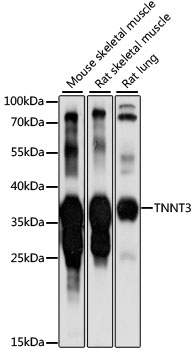TNNT3 Polyclonal Antibody
For reference only. Please follow the manual included in your kit for instructions.
Catalog Number
Product Name
TNNT3 Polyclonal Antibody
Catalog Number
RD88165A
Clonality
Polyclonal
Purification Method
Affinity purification
Isotype
IgG
Host
Rabbit
Background
The binding of Ca(2+) to the trimeric troponin complex initiates the process of muscle contraction. Increased Ca(2+) concentrations produce a conformational change in the troponin complex that is transmitted to tropomyosin dimers situated along actin filaments. The altered conformation permits increased interaction between a myosin head and an actin filament which, ultimately, produces a muscle contraction. The troponin complex has protein subunits C, I, and T. Subunit C binds Ca(2+) and subunit I binds to actin and inhibits actin-myosin interaction. Subunit T binds the troponin complex to the tropomyosin complex and is also required for Ca(2+)-mediated activation of actomyosin ATPase activity. There are 3 different troponin T genes that encode tissue-specific isoforms of subunit T for fast skeletal-, slow skeletal-, and cardiac-muscle. This gene encodes fast skeletal troponin T protein; also known as troponin T type 3. Alternative splicing results in multiple transcript variants encoding additional distinct troponin T type 3 isoforms. A developmentally regulated switch between fetal/neonatal and adult troponin T type 3 isoforms occurs. Additional splice variants have been described but their biological validity has not been established. Mutations in this gene may cause distal arthrogryposis multiplex congenita type 2B (DA2B).
Immunogen Information
Immunogen
Recombinant fusion protein of human TNNT3
Gene ID
7140
Swissprot
P45378
Synonyms
TNNT3TNTFtroponin T3
Calculated MW
67kDa/69kDa/72kDa/74kDa
Observed MW
70-85kDa
Applications
Reactivity
Mouse,Rat
Tested Applications
WB
Conjugation
Unconjugated
Dilution
WB 1:200-1:2000
Concentration
1mg/mL
Storage Buffer
PBS with 0.01% thiomersal,50% glycerol,pH7.3.
Storage Instructions
Store at -20°C Valid for 12 months. Avoid freeze / thaw cycles.
